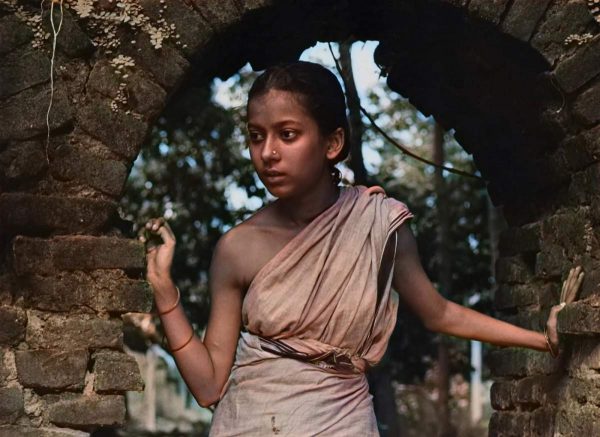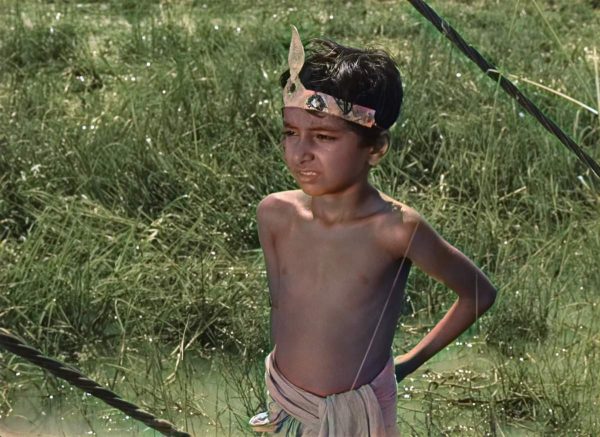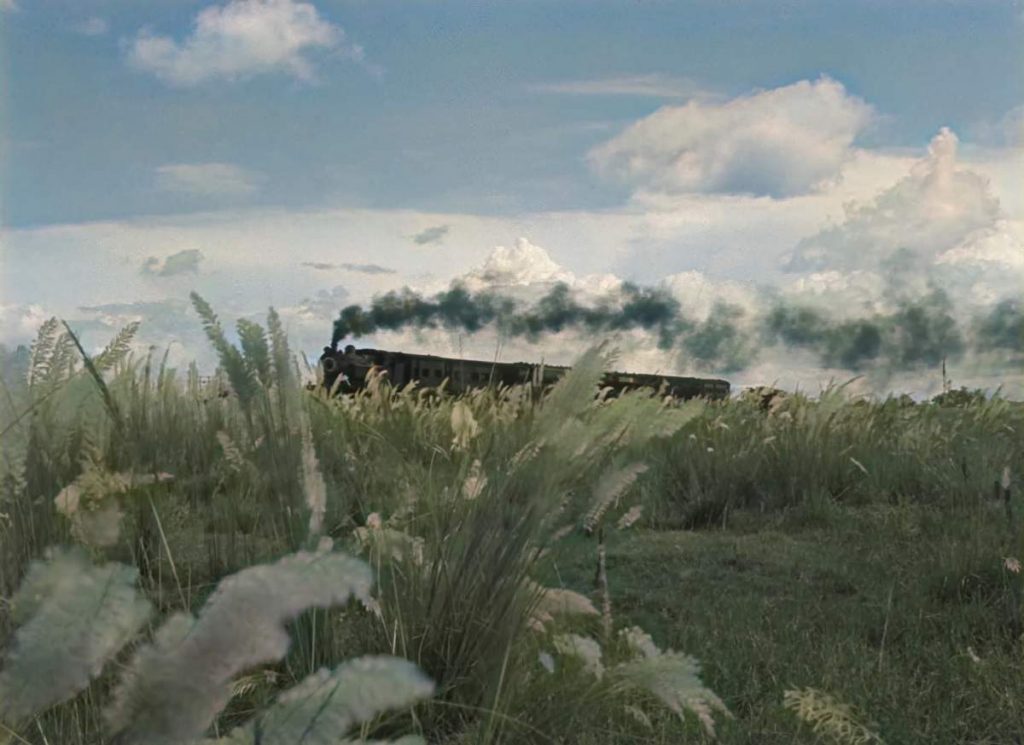Recently, the internet has been awash with strong reactions to the uploading of an almost 3-minute long YouTube video relating to Satyajit Ray’s classic, Pather Panchali (1955), undoubtedly one of the finest Indian films ever made. The video shows portions of Ray’s Black & White masterpiece converted, through AI (Artificial Intelligence), into color. The experiment has been done by Aniket Bera, 30, a professor at the University of Maryland in the United States. He did it during the quarantine in the Corona outbreak, and then uploaded the clip on May 15, 2020. This has led to a heated debate around the world, and specially in West Bengal, whether a B & W classic film should be touched upon in color, even through AI. Bera insists that he did it just as an experiment and reiterates that the best way to watch the film remains the pristine restored version, which has been done by The Criterion Collection, in its original Black & White form. But the debate rages on.
https://www.youtube.com/watch?v=WwwzVSNbg9E
Before we come to the nitty gritty of this debate, let us trace our steps backwards in time.
According to a well-researched study on this subject, film scholar and author Amitava Nag in The Colour of Aesthetics (November 10, 2008) in an online magazine he edits called Silhouette, wrote: “a Mumbai based firm, Sankranti Creations (which added colour to Mughal-e-Azam and Naya Daur) – has proposed to the West Bengal government that owns the Ray classic to colour the movie. The company has set a budget of over Rs. 1.00 crore for the colour project (for a team of 70) and a plan to release it by the end of 2008. However ,there are more controversies in store — Sankranti Creations claims it has already converted one minute of Pather Panchali into colour and sent the demo clip along with its proposal to the West Bengal government. However, the concerned government officials deny any knowledge of such a proposal. Amidst this confusion, most of the intelligentsia – the film-makers, journalists, critics and others, all feel shocked and took little time to hit back.”
“I am quite intrigued to look at the negotiations that take place through Artificial Intelligence. But I would not want to watch Pather Panchali in color. The entire creativity of the original will raise questions springing from the fact that every technician from the cinematographer to the editor, art director and costume designer at the time the film was made, had a definite concept in mind which was specific to and limited by the technology available at the time the film was made. How can the colourization recreate those aesthetics, artistry and skill involved? “ This was a sharp comment from the noted Bengali filmmaker Atanu Ghosh.
According to film critic and author, Amitava Nag, “A Kolkata-based TV Channel, 24 Ghanta conducted a SMS survey on 28th March, 2008, where a whopping 96% responded that Pather Panchali needed no color to uplift its quality or appeal to contemporary viewers. If we look into Hollywood, the conflict over colourising of black-white films started back in the 1980s,” writes Nag going on to add, “Ted Turner was a pioneer in conceptualizing this – he hired American Film Technologies to colourize hundreds of films acquired from MGM in 1986. Inadequate technology resulted in unreal tones and it left much to be desired.”

Coming back to the present controversy, while some have gone ga-ga over the brilliant quality of the visual images, most others are aghast at the tampering of the world-class classic.
One of the most vocal attacks comes from Professor Madhuja Mukherjee, who teachers Film Studies at Jadavpur University and is also a filmmaker in her own right. According to Mukherjee, “Colorization of Pather Panchali does a great disservice to the cinematographer of the film, Subrata Mitra. All tonalities, the grey tones or what Mitra described as ‘sargam’ have been erased …all light intensity are same, skin tones are similar, walls merge with characters – because they are all brown – the density of the image and the long shots have been destroyed as though it was washed with chlorine. It is frankly a very very sloppy work with no understanding of history of color and technology in cinema.” Madhuja goes on to say, “If Mitra had disowned Devi (1960) after he saw it on TV (because of the high contrast restoration), I am wondering what he would have done now. A lot of artists have worked with found footage and with existing material but such experiments through Artificial Intelligence is a really bad example of experimentation. It is like me trying to do something with the Mona Lisa because so many others did it. Indeed, I have been thinking for some time now that quarantine has affected our brains in really adverse ways. The other thing that concerns me deeply are the types of colors used both for saris and for the skin tones. I am not sure if it works as an App or not but in another case – colourisation of the song Jane Kya Tune Kahi from Guru Dutt’s Pyaasa – I saw the same mauve tones for Waheeda Rehman’s sari! Also, the skins are more or same! I am wondering if there are some plugins for ‘Indian skin tones’. I am sorry but we have perhaps fifty shades of brown! As said before, above all it’s really poorly done, very unthoughtful.”
Filmmaker Judhajit Sarkar, a FTII alumnus, says, “American tycoon Ted Turner took over a number of bankrupt Hollywood production companies. He had his own channel TMC, which showed these (horribly) colorized films. There was mixed reaction but the makers, who were still alive, vehemently protested. A petition was also sent to the President. Martin Scorsese was one of the vocal leaders. Satyajit Ray being a sensible and sensitive artist would never have supported such a blasphemous act.”
Amartya Bhattacharyya, whose film Runanubandha – The HE Without HIM (2019) continues to win prizes across the globe, presents a different point of view. “Black & White is not the unavailability of color, it is a different aesthetic altogether. Yes, in those times, there were largely no color films, and that was a restriction so films were conceived in Black & White. It is not just the output that is Black & White. It is an assembly of too many things that together creates a synergy. The synergy makes or breaks a film. Films or photographs are never the same if the same compositions are colored. With color, the entire aesthetic changes. The compositions would change, the use of lights would change, the use of shadows would change, even the edit could change at times. It’s never the same. I know cinema is just a commodity to most people, but it’s better to remember a film the way it was conceived. And no, I don’t have any Ray hangover or obsessions whatsoever. Emotions don’t move me. It’s just an unbiased objective view. I am 100% in support of experiment; of whatever kind it is. But behind every experiment there has to be a strong reasoning and a deep perception of the substrate on which the experiment is been carried out.”
Filmmaker Nirmal Chakravarty makes a very interesting comment. “Rituparno Ghosh made his film Dosar (2006) in Black & White. If someone were to decide to turn it into color, imagine what the film would look like. Of course, it would be a different matter if someone would write a completely new script of the same story and make a completely different Pather Panchali in color.”

Sudeshna Ghosh, a journalist, raises a pertinent question. “I can understand people doing experiments in quarantine, but I am totally against the idea of implementing the same on classics. Color and tone of a film are integral in conveying the mood and story that a filmmaker intended to convey. Changing that changes the aesthetics of the film. I cringe at the thought of the iconic train scene with the ‘kash phool’ in color!”
Shubhrajit Mitra, a noted filmmaker, says, “Though the effort is praiseworthy, the tonal quality lacks richness and emotional depth. It looks like a below average film of the 1960s visually… …Sorbojoya is wearing a blue sari instead of a red bordered Bengali cotton sari, which should have been the original color. There are other glaring flaws such as the lack of reproducing the rural skin tone, which shows lack of research on the part of the creator.”
Putul Mahmood, an award winning filmmaker and an Associate Professor at the Satyajit Ray Film & Television Institute (SRFTI) in Kolkata, is quite amazed at all this bickering. As she says, “What’s the big hue and cry about the coloring of a few frames or sections of Pather Panchali with AI or otherwise? As an academic experiment or otherwise? Nobody can change the original, it remains in its pristine form, we cannot undo its impact, so what’s wrong? Let us not make a sacred cow out of a film masterpiece. Let it be viewed, played around with, knocked down, done over, remixed, celebrated, ridiculed, whatever – why not? The elitist sacred versus profane debate this has set up is truly surprising.” Documentary filmmaker, Surabhi Sharma, seconds Putul adding, “Play around, knocked down, remixed, celebrated, ridiculed… that’s how our relationship with cinema will stay alive and charged.”


